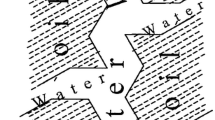Curcumin (C21H20O6) is a natural antioxidant, which is considered to be a very useful compound in health matters, and is employed in the treatment of cardiovascular and arthritic illnesses. It is found that the fluorescence of curcumin is greatly enhanced by mixed micelle of sodium dodecyl benzene sulfonate (SDBS) and cetyltrimethylammonium bromide (CTAB) surfactants. Based on this, a sensitive fluorimetric method for the determination of curcumin in aqueous solution is proposed. In the HOAc–NaOAc buffer, the fluorescence intensity of curcumin is proportional to the concentration of curcumin in the range of 0.00020–0.74 μg/mL and the detection limit is 0.017 ng/mL. The synthetic and actual samples are satisfactorily determined. In addition, the interaction mechanism is also studied.







Similar content being viewed by others
Abbreviations
- CU:
-
Curcumin
- SDBS:
-
Sodium Dodecyl Benzene Sulfonate
- CTAB:
-
Cetyltrimethylammonium bromide
- CMC:
-
Critical micelle concentration.
REFERENCES
C. A. Shih and J. K. Lin (1993). Inhibition of 8-hydroxydeoxyguanosine formations by curcumin in mouse fibroblast cells. Carcinogenesis 14, 709–712.
M. T. Huang, Z. Y. Wang, C. A. Georgiadis, et al. (1992). Inhibitory effects of curcumin on tumor initiation by benao[a] pyrene and 7,12-dimethylbenz[a] mthracene. Carcinogenesis 13, 2183–2186.
M. T. Huang, Y. R. Lou, W. Ma, et al. (1994). Inhibitory effects of dietary curxumin on forestomach, duodenal, and clon carcinogenesis in mice. Cancer Res. 54, 5841–5847.
K. Mehta and P. Pantazis (1997). Antiproliferative effect of curcumin (diferuloylmethane) against human breast tumor cell lines. Anticancer Drugs 8, 470–481.
A. Janssen and T. Gole (1984). Thin-layer chromatographic determination of curcumin(turmeric) in spices. Chromatographia 18, 546–549.
A. P. Gupta, M. M. Gupta and S. J. Kumar (1999). Simultaneous determination of curcuminoids in curcuma samples using high performance thin layer chromatography. J. Liq Chromatogr. Relat. Technol. 22, 1561–1569.
N. S. Krishna Prasad and S. Sarasija (1997). Simultaneous determination of curcuminoids in curcuma samples using high performance thin layer chromatography. Indian Drugs 34, 227–228.
L. Khurana Amrik and T. Ho Chi (1988). High performance liquid chromatographic analysis of curcuminoids and their photo-oxidative decomposition compounds in curcuma longal. J. Liq. Chromatogar 11, 2295–2304.
S. J. Taylor and I. Mcdowell (1992). Determination of curcuminoid pigments in turmeric (Curcuma domestica Val) by reversed-phase high-performance liquid chromatography. J. Chromatographia 34, 73–77.
D. D. Heath, M. A. Pruitt, D. E. Brenner and C. Rock (2003). Curcumin in plasma and urine: quantitation by high-performance liquid chromatography. J. Chromatogr. B 783, 287–295.
Y. Pak, R. Patek and M. Mayersohn (2003). Sensitive and rapid isocratic liquid chromatography method for the quantitation of curcumin in plasma. J. Chromatogr.xs B 796, 339–346.
D. A. Navas and M. C. Ramos Peonado (1992). Fluorometric determination of curcumin in yogurt and mustard. J. Agric. Food Chem. 40, 56–59.
F. Jasim and F. Ali (1992). A novel and rapid method for the spectrofluorimetric determination of curcumin in curcumin spices and flavors. Microchem. J. 46, 209–214.
F. Jasim and F. Ali (1988). A novel method for the spectrophotometric determination of curcumin and its application to curcumin spices. Microchem. J. 38, 106–110.
F. Jasim and F. Ali (1989). Measurements of some spectrophotometric parameters of curcumin in 12 polar and nonpolar organic solvents. Microchem. J. 39, 156–159.
L. Ma (2002). Shandong normal university Thesis for the Masterate.
G. X. Zhao and X. G. Li (1991). Solubilization of n-octane and n-octanol by a mixed aqueous solution of cationic-anionic surfactants. J. Coll. Interf. Sci. 144, 185–190.
H. E. Edwards and J. K. Thomas (1978). A fluorescence-probe study of the interaction of cycloheptaamylose arenes and amphiphillic molecules. Carbohydr. Res. 65, 173–182.
A. Nakajima (1983). A study of the system of pyrene and -cyclodextrin in aqueous solution utilizing the intensity enhancement phenomenon. Spectrochim. Acta A 39, 913–915.
G. Z. Chen, X. Z. Huang and Z. Z. Zheng (1990). Fluorescence Analytical Methods, Science Press, Beijing, p. 15–15.
H. Høiland, O. Kvammen, S. Backlund and K. Rundt (1984). In K. L. Mittal and B. Lindman, Surfactants in Solution. (Eds.), Vol. 2, Plenum, New York, p. 949–962.
P. Ekwall, L. Mandel and P. Solyom (1971). The aqueous cetyl trimethylammonium bromide solutions. J. Coll. Interf. Sci. 35, 519–528.
ACKNOWLEDGMENTS
The Natural Science Foundations of China (20575035) and Shandong Province, (Y2003B02) and a Visiting Scholar Foundation of the Key Laboratory at Shandong University supported this work.
Author information
Authors and Affiliations
Corresponding author
Rights and permissions
About this article
Cite this article
Wang, F., Wu, X., Wang, F. et al. The Sensitive Fluorimetric Method for the Determination of Curcumin Using the Enhancement of Mixed Micelle. J Fluoresc 16, 53–59 (2006). https://doi.org/10.1007/s10895-005-0025-0
Received:
Accepted:
Published:
Issue Date:
DOI: https://doi.org/10.1007/s10895-005-0025-0




